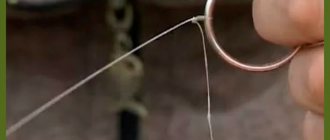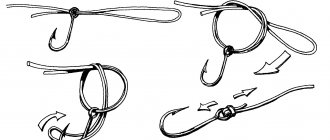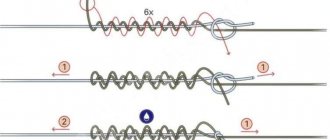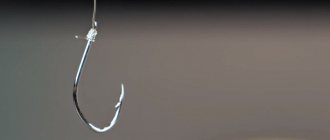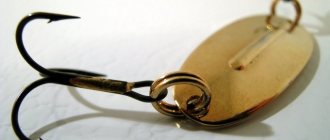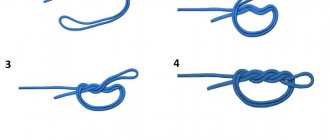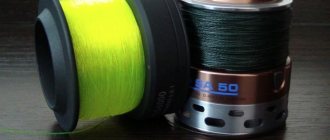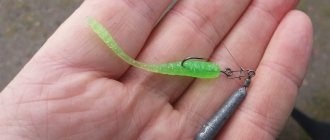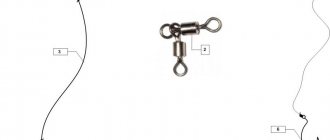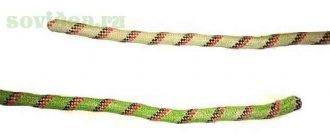Knots and how to tie them – it would seem that what’s so complicated about this? After all, we encounter them in everyday life at every step and tie them without even thinking. From early childhood we were taught to tie shoelaces, girls were taught ribbons and bows, then men learned to tie a tie. And then - in everyday life, fishing, on vacation, hunting, in sports or maritime affairs - one way or another, but knots are present everywhere. Let's figure out how to tie knots on a rope correctly and which ones are the strongest.
What are nodes
Knots have existed for a long time; even our distant ancestors used them to create the first tools, clothing, and obtaining food: hunting and fishing. In essence, a knot is a certain way of weaving ropes, fishing line, ribbons, threads and other things, a way to connect them together or tie them to something by creating a loop.
That is, the nodes have a very long and quite rich history of both application and development. After all, in every business, craft, direction where they were used, they came up with their own types, the most convenient, strong or beautiful, depending on priorities. Such a connection can be woven from a different number of ropes, their different lengths, diameters. They differ in areas of application.
How to tie tourist knots correctly? Results
Let's summarize. All types of rope tourist knots can be divided into a number of conditional categories depending on the scope of their application. Let's highlight the main ones:
This is not a complete list of the purposes of rope knots for tourism. However, having mastered the above set of knots, you will become much more efficient and useful in your hiking life. It is important to remember that each knot must be given special attention in order to knit it correctly. After all, not only your life, but also that of your fellow hikers may depend on your attentiveness. Let your ability to tie knots help you keep yourself and others safe.
More information about the nodes in the video:
Which ones exist?
Knots can be sea, tourist, mountaineering, hunting or fishing - this is a difference in the scope of their application. For example, there are about seven hundred sea knots alone!
Certain requirements apply to each type. For example, tourist ones, in addition to the fact that they must be strong and simple: they must be easy to remember, easy to tie, not crawl under load, not tighten tightly if this is not necessary.
Of course, it is hardly possible to know how to tie knots on all types of rope, and it is not necessary. This is not available to any person on the planet. It is enough to simply understand how to tie knots on a rope tightly and so that they look presentable.
Of course, you won’t get a good, strong connection or the right loop right away. You need to learn how to tie a strong knot in a rope through practice, not just theory. Although it is also necessary to know the theoretical basis. For example, how to tie a knot at the end of a rope: fold the free edges into a loop, leaving a tail of the length that the knot is needed, thread it through it, and tighten it. The knot at the end of the rope is ready!
Varieties
Depending on the purpose of use and the material of the product that will be tied, there are several types of self-tightening knots. Below are just a few of them.
- Simple knot. The simplest and requires no skills. Its density directly depends on the traction force. In order for the knot to be constantly tensioned, it is necessary to apply continuous effort.
- Self-tightening marine knot with half bayonet. A slightly more complicated variation of the first variety. Several half-pins are added to a simple knot, thereby giving it the greatest reliability.
- Constrictor (boa constrictor). It is one of the most durable units. They are very convenient for bandaging round objects that do not have sharp edges. Widely used in medicine for emergency dressing of wounds, application of tourniquets, etc.
A more complicated variety is the double constrictor. It tightens more tightly, making it almost impossible to untie it.
- "Cow" knot. Probably got its name from its original purpose - tying cattle to a support. Despite the name, it is a reliable connecting link for rope made of twine, jute, ropes and cables.
- Fisherman's knot. It is well suited for fishing line, is simple to make, and also has a small diameter, due to which the fishing line tied with such a knot passes well through the holes of the spinning rod. It is also called “bloody” due to the fact that such a knot was originally tied at the ends of a whip, which was used to punish guilty sailors or military men.
- Shakhtarsky. A fairly simple and reliable type of unit. It should be used when the load on the rope is constant. It was originally used in mines, hence its name.
- Camel knot. It is used when it is necessary to attach a thinner one to a thick rope or cable. Once done correctly, you can pull loads at almost any angle, since it does not slip at all. Despite the fact that this type of fastening is quite tight, it is easy to untie - just wet it well with water.
Maybe the whole point is that we don’t know how to knit the right knots, or better yet, we don’t know how to knit the right knots quickly and easily enough? “Soooo. “- you will answer: “What are the “correct” knots and how quickly do you need to be able to knit them?” Let's figure it out together.
The field of application is vast. I use it when I need free attachment of the bait to the fishing line, for example, this is how they recommend attaching a balancer. I use it when I prepare leashes of various lengths in advance for subsequent quick connection when fishing using the “loop to loop” method.
What determines the strength of a knot?
How to tie knots on a rope so that they are strong? The answer to this question is simple: firstly, you need to be able to knit them, no matter how trivial it may sound. And secondly, the rope itself must be strong enough for this, otherwise no matter how much knot tying skills you have, it will be of little use.
Any rope, cord or rope and everything from which knots are tied has its own strength characteristic. Moreover, if a rope is used, for example, to tie a tent to a peg or even a boat to a fishing pier, hardly anyone thinks much about the level of its strength. But in some areas of application of knots such inattention is unforgivable, for example, in mountaineering.
One fact is worth considering: any knot somehow makes the rope less strong, for example:
- the figure-eight knot weakens by a quarter;
- bowline - by a third;
- weaving - by 35%.
All other knots make the rope less strong by about the same amount. Also, for the level of strength of both the rope and the knot, it is worth considering the following:
- if it is wet, then its strength decreases by 10%;
- if used in severe frosts (up to 30 degrees), then it becomes less durable by a third;
- Ropes that are dirty, old, have been in the sun for a lot of time, or with damaged braiding lose half their strength.
Tightening knots
Noose with half bayonets
A hundred years ago, in the sailing fleet, without this unit, the performance of many ship works would have been simply unthinkable. A noose with half bayonets, along with a retractable bayonet, was used on ships to lift up spar trees - topmasts, yards, gaffs, etc. It was used to tie logs in the water for towing, it was used to load cylindrical objects, and loaded rails and telegraph poles. The same knot was used for fastening the main ends of topsail sheets, topsail sheets and other gear where it was necessary to have the ends ready for quick return.
A noose without half-bayonets was often used to secure the mooring line to the shore pole. This knot, proven by centuries of experience at sea, has long been used on shore. It is widely used by lumberjacks. In many foreign languages, the name of this knot is “forest knot” or “log knot.” A noose with half bayonets is a reliable and very strong knot that tightens exceptionally tightly around the object being lifted. The running end of the cable must be passed over the root end inside the loop towards the object being clamped. After the loop is surrounded by the running end 3 - 4 times, it is taken out of the loop and towards the far end, from which there will be traction. At the same time, it is very easy and simple to untie it when the pull on the cable stops.
In order to lift a tree trunk of several tons or a heavy metal pipe without risking human life, it is not necessary to have any special rigging equipment for a crane. You can get by just fine with a plant cable of appropriate strength or a steel cable. But for this you need to be able to tie this knot correctly. It should always be knitted slightly away from the middle of the log (pipe). Having removed the running end of the cable from the loop that makes up the knot, it is pulled towards the end of the object being lifted, from which there will be traction, and two half-bayonets are made. But, as a rule, two half-bayonets are made before the start of tying the noose, since the root end of the tackle is already secured (b). The slack of the cable between the noose and the half bayonets must be selected before lifting.
Having lifted an object with a crane, it is better to deliver it to its place in one step, without lowering it to the ground. You should always remember that this unit must be checked before each lift (if it is carried out in two steps). It is also important in which direction to make half-bayonets on the log. They should be laid along the descent of the cable. Lifting heavy objects with a noose without half bayonets is considered dangerous.
Application options
Knots are found even in everyday life at every step, and they can be both functional and simply decorative. For example, recently, bracelets or necklaces made from cords, laces and thin ropes tied in beautiful knots have become especially popular.
They are also used to tie two ropes of the same thickness. In tourism, instead of ropes, other materials of different thicknesses can be used. Using a knot, you can tie a wide variety of loops: tightening, climbing, quick-release (aka bow), bowline, or those that are very difficult to untie. Keep in mind that most knots lead to chafing of the rope and also tend to unravel on their own.
Knot
Probably the most famous of all knots. You may not know how to tie it, but everyone has probably heard about it. What is it and how to tie a sea knot on a rope?
First of all, it must be said that there are several sea knots, and each of them has its own name: running simple, reef, bowline, snare, scaffold. All of them are tightening loops, with the help of which the ship was tied to the pier. Their peculiarity is a certain way of knitting and tightening the rope, in which it is stretched, making the knot reliable. And when the rope is loosened, the noose is easy to untie.
The bowline or arbor knot is most often used. There is nothing difficult in learning how to tie it, and such a skill can come in handy at any time. Tie it as follows:
- a small loop is made, a piece of rope of such length as the size of the knot is needed is left in stock;
- this end is threaded through the loop, as when tying a simple knot;
- wraps around the free end of the rope, threads it through the small one and tightens.
We teach children to knit sea knots: patterns, games and clear examples
One day there comes a time when you need to use special skills. I want to tell you how to tie a sea knot. Knots surround us everywhere we look: on shoelaces, clotheslines, car ropes and climber's belays. Any knot can be tied accidentally, for example, on headphones or sewing threads. Sometimes it is strong, and sometimes it is enough to pull the strings in different directions and they will come undone. But sea knots are completely different.
Previously, when the first ships just began to plow the surface of the water, people needed very reliable, strong ties for fastening. It was vitally important that the tree not become loose from the waves beating against the side, that the anchor not be carried away by the current, and that the sails not be torn off by the wind. Sailors came up with super-strong weaves, and even with a secret: which can be easily untied in one movement, pulled up, secured on a stick, or plugged into a hole... there are a lot of uses for knots. But today I will tell you about the most interesting ones that will help you more than once in a difficult situation!
Nautical knots - how to tie them correctly?
There are a great variety of sea knots for every job and situation. Every sailor should know about 100 types, be able to tie them and use them correctly. The science of all kinds of weaves is studied at the maritime school. Cadets who want to sail the seas first look at a diagram of sea knots and then try to repeat it.
- Straight knot. Since ancient times it has been used to tie ropes. Its other names are reef, hercules. Tying it couldn't be easier. One end of the rope is pulled in one direction, and the other in the opposite direction. However, the straight knot is considered not very reliable; when wet and under heavy load, it can slip.
- The king of sea knots is the bowline, or, as it is also called, the “gazebo”. All sailors without exception know and use it. The bowline is used for many things at once: belaying, mooring, attaching a cable, tying two ropes. It never slips. Strong, reliable, the bowline will never untie itself. But if necessary, it can be untangled in less than a minute. In the absence of tension, without load, the threads easily diverge.
- Eight. Such a knot is usually tied at the end of the rope in order to secure it in the hole and prevent it from slipping out. In other words, seal the end. For example, using a figure eight knot you can replace a broken bucket handle or tie a cable to a children's sled.
- Python. A very useful sea knot. With its help it is easy to connect sticks or slats crosswise. He will help you make a ladder or build a hut if you accidentally get lost in the forest.
- Burlatskaya loop. To tie it, you first need to make a ring, and then break it in half, and thread the edge inward and tighten it. The Burlatsky loop is used as a ladder, and also for pulling heavy loads by a group of people.
Practice tying sea knots on thick, dense ropes, such as clotheslines. With ordinary threads, the desired effect may not be achieved due to their excessive softness. In addition, being thin, they easily get tangled, tear, and are generally extremely inconvenient for children's fingers.
Why is it so useful to tie sea knots?
At first, it may seem that learning how to tie sea knots is not interesting for children. That there is no need or benefit for this. But this is absolutely not true. This skill will definitely come in handy for your child more than once:
Along the way, by mastering the science of knitting sea loops, children improve and develop:
- fine motor skills improve – finger movements become more dexterous;
- creative abilities are manifested;
- abstract and figurative thinking works;
- The child is better oriented in space and learns to work with diagrams.
Playing with ropes is gymnastics not only for the hands, but also for the mind. This is not what I’m saying, this is what the great teacher Maria Montessori believed, according to whose system Bill Clinton, Bill Gates, George Clooney and other successful celebrities studied.
To increase the strength of a sea knot, after tying it, you need to wet it and lightly pull the ropes in different directions (tighten). After drying, the knot will become even stronger than it was. After all, water is an integral component of sea knots.
Let's play!
Sea knots are not only useful. Armed with a rope and knowing a few simple weaves, you can play very excitingly. Some examples of game scenarios for children:
- Pirate battle. How about being a pirate for a bit? Divide into 2 teams. Quite by accident, you simultaneously found a treasure - a heavy treasure chest. But only strong pirates who are able to pull him out of the pit will be able to take him. What will you need for this? That's right, a burlatk knot. Whoever quickly ties as many knots on a rope as there are players on the team wins!
- The most skillful captain. To become a real sea wolf, you will have to use many different knots. Who wants to test their strength? Here are 5 pieces of rope and diagrams of sea knots. The first person to tie them all must raise their hands up. We recognize him as the most skillful captain of a sea vessel!
- Outdoor game "Sea Knot". Guys, you did a great job and mastered a very useful skill of tying knots. But how tough and resourceful are you? Let's check. Divide into 2 teams and choose a captain. Crew, form a line! Hold each other's hands tightly! Now captains, listen to the task. You need to tie the opposing team into a knot (rearrange without breaking hands) so that the opposing captain cannot quickly unravel. Go! Ready? Now untie the sea knot and free the crew of your ship. Whoever manages it first wins!
Every real boy should know how to tie a bowline, straight, figure eight, python, burlatsky knot. One day they will help you cope with an unexpected situation. You can come up with a lot of exciting games with them: make fishing rods and go fishing, build a hut and much more. It is also useful for girls to learn a skill to increase dexterity. Use the diagrams and you will see how simple and fun it is to immerse yourself in the world of sailors and ships!
For tying two ropes
It happens that it is necessary to tie two or even more ropes together, and also add knots to already tied ropes. There are special loops for these purposes. So, how to tie a knot on a tied rope using a Flemish loop or a counter figure eight, which is one of the oldest, strongest and strongest:
- at the end of an untied rope, make a figure eight from its free edge;
- With the remaining end of the knotted one, they repeat the bends and thread them through them, while tightening the loop.
This knot practically does not weaken the strength of the rope, and is easy to untie if necessary.
Untied knot
Sometimes it is necessary to tie a loop that will not come undone under any circumstances. As a rule, these are tightening knots. Weaving is considered one of these. So, how to tie a strong knot on a rope that will definitely not come undone at the most inopportune moment? First of all, you need to understand that it is a combination of two knots, which are tied with running ends around the base:
- lay two ropes with ends facing each other;
- make a simple knot at one end;
- pass the end of the other through the loop made on the first, make a turn around its base;
- tie the same simple knot with the second rope;
- move both loops towards each other until they come together;
- Tighten the knot properly.
This is a very strong knot; for all its apparent simplicity, when pulled, it becomes so strong that it seems unlikely to untie it.
Beautiful knot
Of course, not all loops and knots serve exclusively for functional purposes; they are also used to create jewelry: bracelets, necklaces. Knots are also tied simply for good luck, used in macrame techniques, lace making and more.
And this is where knowing how to tie a beautiful knot on a rope comes in handy. But there are quite a lot of such knots, so we’ll tell you about a couple of the easiest and most attractive ones.
Everyone remembers and knows how to braid a pigtail. So, if you intertwine one or more ropes in this way, you get a beautifully tied braid of knots.
Another popular pattern is a woven crown or, using the terminology of the macrame technique, cobra. Used to create textile bracelets, necklaces, baubles, keychains and laces for an umbrella or a dog leash. It is knitted from four ropes as follows:
- connect the ends of the ropes together;
- turn the ends towards you;
- tie a crown knot, making a loop from each rope and pulling the end that lies behind it into it;
- tighten and continue tying knots to the desired length.
The braided crown lace is ready! Now you can close its ends with special caps with a clasp, which can be purchased at a jewelry supply store, and use them as a bracelet or necklace.
